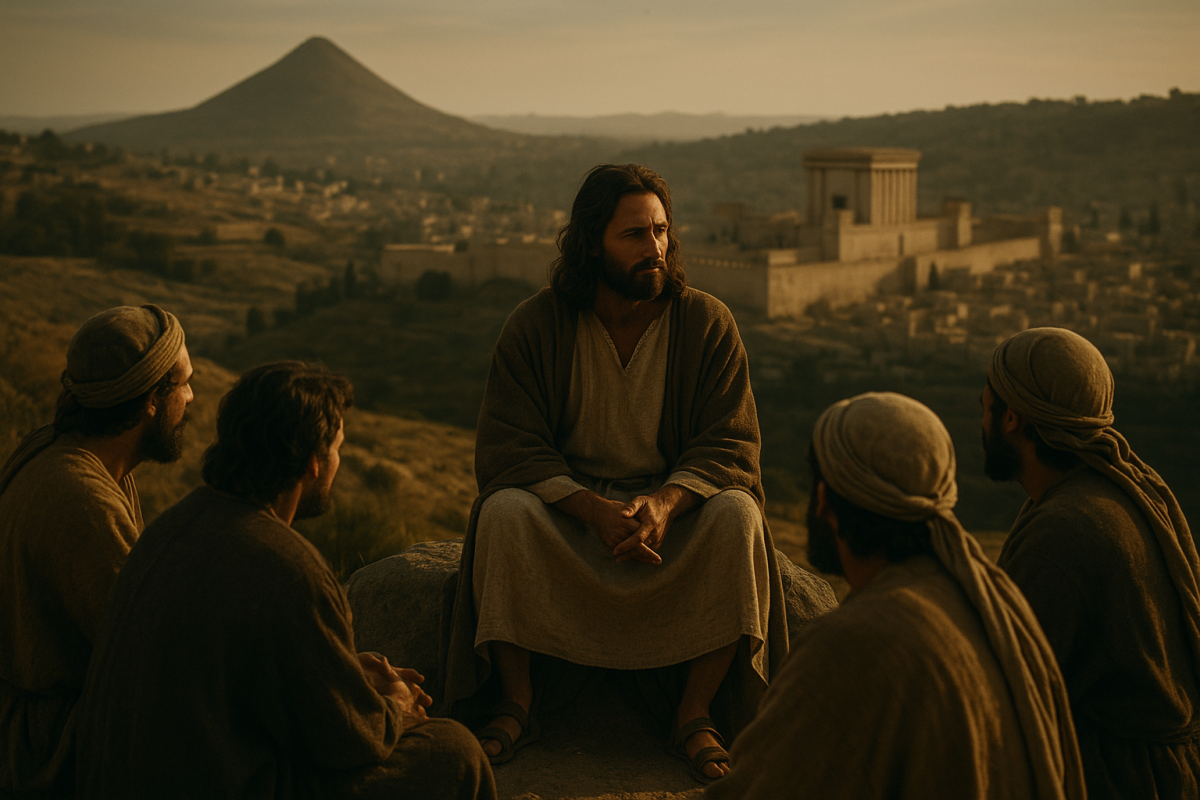
Yeshua’s “Parousia” on the Mount of Olives
Devarim and Matthew 24: A Shared Pattern
The Torah portion Devarim if often tied to Matthew 24. At first glance the connection may seem tenuous. Moses standing east of the Jordan preparing Israel for the Promised Land, Yeshua sitting east of Jerusalem preparing His disciples for the end of the age. Yet beneath both moments lies a shared pattern rooted in the ancient Near Eastern world: the cosmic mountain.
The Cosmic Mountain in the Ancient Near East
In the ANE imagination, the cosmic mountain stood as the primary symbol of divine presence, authority, and cosmic order. It was the sacred center, the navel of creation, the place where heaven and earth converged. Here gods were enthroned, kings ascended their thrones, and cosmic decrees were issued. Israel’s story reframed this pattern. Sinai, Zion, and the Mount of Olives each became stages where Yahweh’s kingship was revealed and reasserted.
Yeshua on the Mount of Olives
So imagine the scene in Matthew 24. Yeshua had just left the Temple. The disciples, stunned by His prophecy of its destruction “not one stone here will be left upon another” follow Him eastward. They cross the Kidron Valley and climb the Mount of Olives, that ridge long shadowing Jerusalem from the east. There, with the Temple still in full view, He sits. His disciples come privately, and ask: “Tell us, when will these things be? And what will be the sign of Your coming, and of the end of the age?” (Matt. 24:3).
The Meaning of Parousia
That word, “coming,” is parousia. It does not simply mean arrival in the sense of showing up. It carries the weight of presence, royal presence. In the Greco-Roman world, a parousia was the official visit of a ruler or emperor. His return to a city was heralded as his “second coming.” When he arrived, his presence was felt in unmistakable ways: military parades, decrees of clemency, feasts of abundance, public games, distributions of food and gifts. His coming reasserted dominion and celebrated sovereignty.
To ask Yeshua about His parousia was politically charged, subversive in the extreme. In a world where Caesar was hailed as “Son of God,” “Lord,” and “Savior,” the disciples were asking Yeshua: When will You come in glory as the true King? When will Your dominion be revealed, not Rome’s?
And notice: Yeshua does not answer this question from the Temple Mount. He speaks from the Mount of Olives. The choice is deliberate. Because the Presence has relocated.
Prophetic Background of the Mount of Olives
Ezekiel saw it long ago. When the glory of Yahweh departed from the First Temple, it did not vanish into thin air. The prophet describes the Glory rising, leaving the threshold, and coming to rest east of the city on the Mount of Olives (Ezek. 11:23). The mountain became the place of divine presence, awaiting the day of return.
The prophets saw more. Zechariah envisioned the Day of the Lord when Yahweh Himself would descend to fight for His people. His feet would stand on the Mount of Olives, the very place where He had departed, and the mountain would split under the weight of His arrival. From that place the Lord would reign as King over all the earth (Zech. 14:4–9).
The Relocation of God’s Presence
The pattern is unmistakable. Yeshua’s Olivet Discourse is not simply a teaching on end-time signs; it is a declaration that He Himself is the Glory returning to the mountain. The location interprets the message. Though the current Temple is destined for ruin, the Presence of God is not lost. It has shifted to a new cosmic mountain.
The Mount of Olives in Yeshua’s Mission
This is why the Mount of Olives becomes such a focal point in Yeshua’s mission. It is the place where He prays and sweats blood before His arrest. It is the place where Judas leads the soldiers to betray Him. It is the place of testing, like Sinai was for Moses and Elijah. And most significantly, it is the place of His ascension. From the Mount of Olives He rises into heaven, clothed in resurrection glory, enthroned at the right hand of the Father. The angels promise His disciples that “this same Yeshua… will return in the same way you saw Him go” (Acts 1:11). In other words, His parousia will mirror His ascension back to the Mount of Olives.
The Sign of His Coming
In Matthew 24 the disciples ask for a sign of His coming. Yeshua warns them of false messiahs, wars, earthquakes, famines the shaking of creation itself. Yet the deepest sign is theological, not geopolitical: the Presence at that time has shifted. The Temple will be destroyed stone by stone, but the Presence has taken His seat on this mountain for now. His parousia is bound to the faithfulness of God who promised that His Glory would one day return to reign.
A Place of Reversal and Hope
This mountain is also the place of reversal. David once fled Jerusalem weeping, climbing the Mount of Olives in exile as Absalom seized the throne. Yet he returned in triumph. Yeshua retraces that royal path. He ascends Olivet not as an exile but as the greater Son of David, the rejected King who will return in power.
So what does all this mean for us? It tells us that in Yeshua’s day the cosmic mountain has moved. And it reminds us that God’s Presence is revealed in the enthroned Messiah. And it assures us that His parousia, His royal presence, is already breaking into history even as we await its final unveiling.
The True Sign of His Parousia
The disciples asked: What will be the sign of Your coming, and of the end of the age? The answer, in part, is that the end of the age, which referred to the destruction of the Temple by Rome in the first century, will come and the Presence will relocate to the Mount of Olives as shown in the book of Acts. When the old order crumbles, the King ascends. When the Mount of Olives becomes a throne room where heaven and earth meet.
The sign of His parousia is not merely political upheaval or cosmic disturbance. It is the Presence of Yahweh in Yeshua, enthroned on the mountain, coming again as the true Son of God, Lord, and Savior. Caesar may stage his parades, but the nations will see the Son of Man coming on the clouds with power and great glory.
